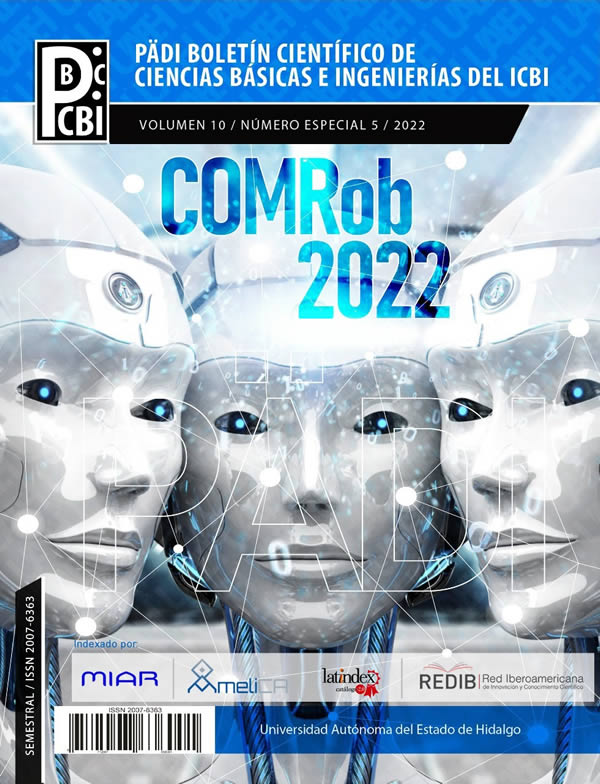Esquema líder-seguidor para robots móviles tipo-uniciclo con cámara montada
DOI:
https://doi.org/10.29057/icbi.v10iEspecial5.10149Palabras clave:
Control de formación, robots móviles tipo-uniciclo, control servo-visual basado en imagen, validación experimentalResumen
Este artículo describe una propuesta de control de formación para robots móviles tipo-uniciclo bajo el esquema líder-seguidor con cámara montada. El objetivo de control es determinado directamente en el espacio de imagen, por lo que esta propuesta corresponde a la alternativa de Control Servo-Visual Basado en Imagen (IBVS por sus siglas en inglés). Utilizando la teoría de estabilidad de Lyapunov, dos controladores son diseñados: uno que depende parcialmente de los parámetros del sistema de visión y otro que es robusto a los parámetros tridimensionales de las características que son mapeadas al espacio de imagen (las características de imagen). Finalmente, se realizan experimentos satisfactorios sobre una plataforma de tiempo-real blando para validar la teoría propuesta.
Descargas
Información de Publicación
Perfiles de revisores N/D
Declaraciones del autor
Indexado en
- Sociedad académica
- N/D
Citas
Antonelli, G., Arrichiello, F., Chiaverini, S. (2006). Experiments of formation control with collision avoidance using the null-space-based behavioral control. In: Proceedings of IEEE Mediterranean Conference on Control and Automation, Ancona, Italy. pp. 1-6.
Belta, C., Kumar, V. (2002). Trajectory design for formations of robots by kinetic energy shaping, Proceedings of IEEE International Conference on Robotics and Automation. Washington, USA. pp. 2593-2598.
Benhimane, S., Malis, E., Rives, P., Azinheira, J. R. (2005). Vision-based control for car platooning using homography decomposition. In: Proceedings of IEEE International Conference on Robotics and Automation. Barcelona, Spain. pp. 2161-2166.
Bugarin, E., Aguilar-Bustos, A. Y. (2014). Control visual para la formación de robots móviles tipo uniciclo bajo el esquema líder-seguidor. Ingeniería, Investigación y Tecnología. XV(4): 593-602.
Canudas de Wit, C., Siciliano, B., Bastin, G. (1996). Theory of Robot Control. Springer-Verlag, London, U.K.
Consolini, L., Morbidi, F., Prattichizzo, D., Tosques, M. (2006). On the Control of a Leader-Follower Formation of Nonholonomic Mobile Robots. In: Proceedings of the 45th IEEE Conference on Decision & Control. San Diego, CA, USA. pp. 5992-5997.
Das, A. K., Fierro, R., Kumar, V., Ostrowsky, J. P., Spletzer, J., Taylor, C. (2002). A vision-based formation control framework. IEEE Transaction on Robotics and Automation, 18(5):813-825.
Dani, A. P., Gans, N., Dixon, W. E. (2009). Position-Based Visual Servo Control of Leader-Follower Formation Using Image-Based Relative Pose and Relative Velocity Estimation. In: Proc. American Control Conference, St. Louis, MO, USA. pp. 5271-5276.
Dixon, W., Dawson, D., Zergeroglu, E., Behal, A. (2001). Nonlinear Control of wheeled mobile robots, Springer, London, U.K.
Guo, D., Wang, H., Chen, W., Liu, M., Xia, Z., Leang, K. (2017). A unified Leader-Follower Scheme for Mobile Robots with Uncalibrated On-board Camera. In: IEEE International Conference on Robotics and Automation. Singapore. pp. 3792-3797.
Hill, J., Park, W. T. (1979). Real time control of a robot with a mobile camera. In: 9th ISIR, Washington, D. C. pp. 233-246.
Hutchinson, S., Hager, G., Corke, P. (1996). A tutorial on visual servoing. IEEE Transactions on Robotics and Automation, 12(5): 651-670.
Khalil, H. (2001). Nonlinear systems, Prentice Hall, 3ed.
Kelly, R., Reyes, F. (2000). On vision systems identification with application to fixed camera robotics systems. International Journal of Imaging Systems and Technology, 11(3): 170-180.
Li, Z., Yuan, Y., Fan, K., Wei, H., Chun-Yi, S. (2019). Robust Vision-Based Tube Model Predictive Control of Multiple Mobile Robots for Leader-Follower Formation. In: IEEE Transactions on Industrial Electronics. pp. 1-10.
Liang, X., Wang, H., Liu, H., Chen, W., Liu, T. (2018). Formation Control of Nonholonomic Mobile Robots without Position and Velocity Measurements. In: IEEE Transactions on Robotics. 34(2) pp. 434-446.
Mariottini, G. L., Morbidi, F., Prattichizzo, D., Pappas, G. J., Daniilidis, K. (2007). Leader-Follower Formations: Uncalibrated Vision-Based Localization and Control. In Proc. IEEE Int. Conf. on Robotics and Automation. pp. 2403-2408.
Min, H. J., Drenner, A., Papanikolopoulos, N. (2009). Vision-based Leader-Follower Formations with Limited Information. In: IEEE International Conference on Robotics and Automation, Kobe, Japan. pp. 351-356.
Roberti, F., Toibero, J. M., Vassallo, R. F., Carelli, R. (2011). Control Estable de Formación Basado en Visión Omnidireccional para Robots Móviles No Holonómicos. Revista Iberoamericana de Automática e Informatica Industrial. 8(1): 29-37.
Shao, J., Xie, G., Yu, J., Wang, L. (2005). Leader-following formation control of multiple mobile robots. In: Proceedings of IEEE International Symposium on Intelligent Control, Limassol, Cyprus. pp. 808-813.
Soria, C. M., Carelli, R., Kelly, R., Ibarra, J. M. (2006). Coordinated control of mobile robots based on artificial vision. International Journal of Computers, Communications, and Control. 1(2):85-94.
Vidal, R., Shakernia, O., Sastry, S. (2003). Formation control of nonholonomic mobile robots with omnidirectional visual servoing and motion segmentation. In: Proc. IEEE Int. Conf. on Robotics and Automation, Taipei, China. pp. 584-589.
Wang, Y., Shan, M., Yue, Y., Wang, D. (2019). Vision-Based Flexible Leader-Follower Formation Tracking of Multiple Nonholonomic Mobile Robots in Unknown Obstacle Environments. In: IEEE Transactions on Control Systems Technology. pp.1-9.




















